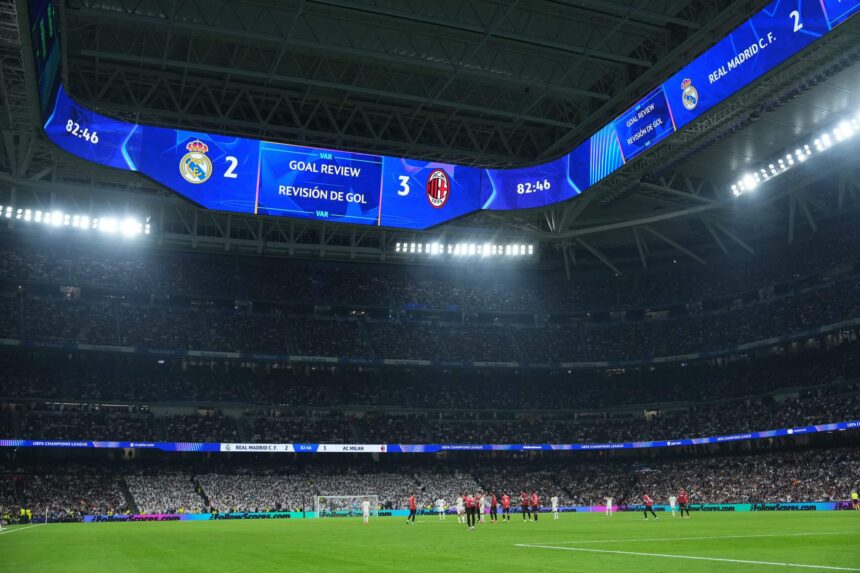Premier League fans will finally get to see how SAOT (semi-automated offside technology) works when it reaches the English top flight on the weekend of April 12-13.
It should be an important addition, helping reduce the time needed to make offside decisions and produce clearer graphic visualisations of offside decisions.
SAOT has already been used at the most recent women’s and men’s World Cups (Australia and New Zealand 2023 and Qatar 2022), in the Champions League since 2022-2023, in Serie A from January 2023, and it was introduced in La Liga at the start of this season. It has also been trialled in the fifth and sixth rounds of this season’s FA Cup.
SAOT has been operating in the Champions League since 2022-23 (Angel Martinez/Getty Images)
What is SAOT?
SAOT is a tool for the video assistant referee (VAR) that automates key elements of the offside decision-making process. These key elements are the ‘kick-point’ (the exact time the ball was played) and the positioning of the relevant defender and attacker.
For offsides, VAR confirms or recommends a change to onfield decisions made by the referee and linesmen on close calls, so SAOT will assist with these verdicts.
Advertisement
How these calls are currently judged, without SAOT, is through replay operators (RO), who manually determine the ‘kick-point’ for the offside decision and then draw lines on the relevant defender and attacker using multiple camera angles. A decision is then generated and a player can be judged offside by any part of the head, body, or feet. This current process has been criticised for taking too long.
(Darren Staples/AFP via Getty Images)
When and where is it being used?
As reported by The Athletic today, semi-automated offside technology will make its Premier League debut next weekend (April 12-13).
SAOT will be another acronym for fans to get used to. It was originally intended to be introduced “after one of the autumn international breaks”, according to the league, but this was delayed.
Premier League clubs unanimously approved its introduction for the 2024-2025 season back in April 2024, but it has taken a year to finally arrive.
SAOT will be operating at Bournemouth on Saturday (Mike Hewitt/Getty Images)
How will it work?
SAOT will automate the job of a replay operator by suggesting a ‘kick-point’ and automatically creating offside lines on the second furthest back defender and the relevant attacker. The Premier League says this will save an average of around 31 seconds per offside.
The SAOT decision is then reviewed and approved by the VAR and automatically creates a visual display shown on stadium screens for fans.
Up to 30 new cameras have been installed around each Premier League stadium to support the system and many will capture footage at twice the frame rate of typical broadcast cameras — 100 frames per second.
During the two World Cups featuring SAOT, FIFA used ‘connected balls’ with chips in them to be precise about the ‘kick-point’, but the Premier League do not feel a chip is required as the cameras used will track the exact movement of the ball.
Players are also continuously tracked using 10,000 data points on the bodies of all 22 on-field players, helping automatically determine whether or not the attacker was offside at the ‘kick-point’ and flagging if any offside player was involved in the build-up to an incident to the VAR and SAOT operator.
SAOT is fully automated and can be overseen by one operator; VAR requires several people to do the job of SAOT manually.
Will this increase accuracy?
It will not affect the accuracy of offside decision-making but is intended to increase the speed at which decisions are made.
Technically, Premier League offside decisions cannot get any more accurate — they have been judged to be 100 per cent accurate so far this season, according to the FA.
However, complaints about time delays when studying marginal offside calls have not disappeared in what is VAR’s sixth season in England’s top flight.
SAOT should speed things up, although it is not perfect — as evidenced by a seven-minute offside check in the Bournemouth vs Wolves FA Cup tie in March. A potential handball complicated the check, so the old manual method was utilised.
(Carl Recine/Getty Images)
What does this mean for VAR?
The technology is considered ‘semi-automated’ as it still requires human input from the video assistant referee, who confirms the decision and reviews the ‘kick-point’ and whether the players highlighted and the parts of their body being compared are accurate.
A VAR could also conclude that the referee needs to conduct an on-field review for a ‘subjective’ offside call, such as when an attacking player does not touch the ball but could be interfering while in an offside position.
The VAR will still have the option to draw lines in the case of an SAOT failure or when players are blocking the view of the ball or the system’s cameras, so-called ‘edge cases’.
(Top photo: Mike Hewitt/Getty Images)
